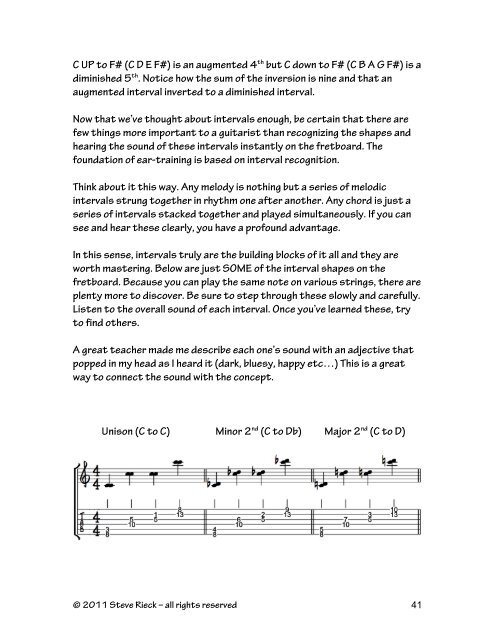Fretboard Evolution Vol. I - Steve Rieck
Fretboard Evolution Vol. I - Steve Rieck
Fretboard Evolution Vol. I - Steve Rieck
Create successful ePaper yourself
Turn your PDF publications into a flip-book with our unique Google optimized e-Paper software.
C UP to F# (C D E F#) is an augmented 4 th but C down to F# (C B A G F#) is a<br />
diminished 5 th . Notice how the sum of the inversion is nine and that an<br />
augmented interval inverted to a diminished interval.<br />
Now that we’ve thought about intervals enough, be certain that there are<br />
few things more important to a guitarist than recognizing the shapes and<br />
hearing the sound of these intervals instantly on the fretboard. The<br />
foundation of ear-training is based on interval recognition.<br />
Think about it this way. Any melody is nothing but a series of melodic<br />
intervals strung together in rhythm one after another. Any chord is just a<br />
series of intervals stacked together and played simultaneously. If you can<br />
see and hear these clearly, you have a profound advantage.<br />
In this sense, intervals truly are the building blocks of it all and they are<br />
worth mastering. Below are just SOME of the interval shapes on the<br />
fretboard. Because you can play the same note on various strings, there are<br />
plenty more to discover. Be sure to step through these slowly and carefully.<br />
Listen to the overall sound of each interval. Once you’ve learned these, try<br />
to find others.<br />
A great teacher made me describe each one’s sound with an adjective that<br />
popped in my head as I heard it (dark, bluesy, happy etc…) This is a great<br />
way to connect the sound with the concept.<br />
Unison (C to C) Minor 2 nd (C to Db) Major 2 nd (C to D)<br />
© 2011 <strong>Steve</strong> <strong>Rieck</strong> – all rights reserved 41


